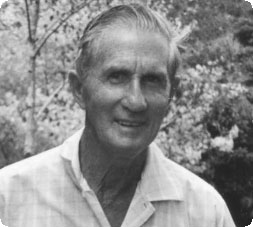 |
 |
|
Neil HollinsNeil Hollins has lived all his life as a farmer in the Wakool district, which was one of the first areas to benefit from the development of irrigation in the Southern Riverina. His family was involved in first experimental growing of rice in the district on their property "Woorak" during World War II. INTERVIEW TRANSCRIPTKey topics: Arrival of irrigation, experimental rice growing, rising water tables subsurface drainage, domestic life, prisoners-of-war, Tulla, soldier settlement, irrigation layouts, soils. The following text is based on an edited transcript of an interview recorded with Mr Neil Hollins in December 2004. Our parents came from Gippsland, down near Dalyston - it was something to do with the railways and the border railway agreement, to open up blocks along the railway and Dad bought one of those blocks. They had wool and I don't think they had fat lambs initially because it was a dry area. I know my father grew 400 acres of wheat before irrigation and got 400 bags off it and that sort of nearly stonkered him. He had 880 acres there which was the average size for a block at the time. And looking at some records I had a look here, they grew seven bales of wool. Water changes the story The irrigation started here, I think it was in 1936 or37. Initially they had a number of meetings locally with landholders to see whether we wanted any irrigation in this area, the Wakool area. And they had a meeting at what they called Dick McConnell's Woolshed located just quarter of a kilometre south of Burraboi. Prior to that, they were going to put irrigation through Berrigan and Finley who did not want it at the time and they put the Stevens Weir in to supply Wakool. There was a lot of big landholders didn't want water because they'd have to be paying a water right, which they didn't want. And the big landholders didn't like it, where the small landholders were just hanging on by their teeth sort of thing and they needed water to change the story. When the water was brought in first they told the dad that he only had 40 acres suitable for growing pastures on. That was just around the house which was of a loamy nature, very loamy nature. The rest wasn't suitable. So he laid that out into border check. At the time we went from seven bales of wool to 130 I think one year. But we didn't have rice in those days and mostly pasture. Experimenting with rice Experimentally, we began growing rice with the government in 1943. Dad cultivated the paddock which was of about three or four acres and put the banks up. He had a John Deere Model D tractor, steel wheels, the only one in the area more or less. And he did all the earthworks for the Water Commission at the time. It was a success, although it was delayed in harvesting because they couldn't find a machine to harvest it with. They did bring a header down from Leeton, what they call a coffee pot type of header, it had a big water cooling tank on the front. But it was late harvested and there was a bit of loss. It was successful enough to continue the trials. There was a lot of government people come to have a look at it and checked it and an agronomist and that's what started the major job out in Tulla, as it was called then. They experimented on our farm for just the one year. They commenced rice growing at Tulla the very next year. I have a lot of literature covering it but I remember they had surveyors there, crawling all over the place to get all these new earthworks channels, a lot of flash new equipment that we'd never seen before, because it was an Allied War Council project. They procured equipment, being during the war – well, they found them somewhere, I don't know – it comes from America most of it, all the new equipment. A lot of channels had to be made and what have you. And then they had multiple small tractors to cultivate with and the same with equipment. |
You'll need to get the Flash Player to hear the audio. |
|
| sitemap • credits
& references • copyright • local
history links • contact & contribute • VISITORS |
||
